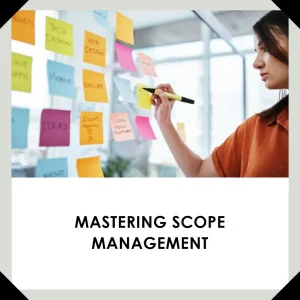Introduction to Bottom-Up Estimating and Earned Value Management
Effective estimation and tracking are crucial for ensuring project success. Two methodologies that stand out in this regard are bottom-up estimating and Earned Value Management (EVM). Understanding these practices and their integration can significantly enhance project controllers’ and PMO professionals’ ability to manage projects efficiently.
Defining Bottom-Up Estimating
Bottom-up estimating is a detailed project management technique that involves breaking down a project into its smallest components, such as individual tasks or work packages. Each of these components is assessed for its time, cost, and resource requirements, allowing for a comprehensive estimation of the overall project. This method is particularly valued for its accuracy, as it draws on detailed inputs from team members who are familiar with specific tasks, leading to more reliable estimates [1][9]. By aggregating these granular estimates, project managers can develop a clearer picture of the total project cost and timeline, which is essential for effective planning and execution [2][4].
Understanding Earned Value Management (EVM)
Earned Value Management is a systematic approach used in project management to measure a project’s performance and progress. EVM integrates project scope, schedule, and cost variables to provide a comprehensive view of project health. It allows project managers to assess how much work has been completed at any given point in time and compare it against the planned progress and budget. This methodology is crucial for tracking project performance, as it helps identify variances and trends that may indicate potential issues [10][15]. By utilizing EVM, project managers can make informed decisions and adjustments to keep projects on track.
The Relevance of Integrating Bottom-Up Estimating with EVM
Integrating bottom-up estimating with Earned Value Management creates a powerful synergy that enhances project management practices. The detailed estimates generated through bottom-up estimating provide a solid foundation for the EVM framework. When project managers have accurate and granular cost and duration estimates, they can establish more reliable performance baselines for EVM. This integration allows for:
- Improved Accuracy: The detailed nature of bottom-up estimates contributes to more precise EVM calculations, leading to better tracking of project performance [3][9].
- Enhanced Forecasting: By combining the insights from both methodologies, project managers can better predict future performance and resource needs, facilitating proactive management [6][9].
- Informed Decision-Making: The integration allows for a clearer understanding of project status, enabling project controllers to make timely and informed decisions to address any deviations from the plan [10][12].
Understanding Bottom-Up Estimating
Bottom-up estimating is a fundamental technique in project management that focuses on estimating costs, durations, and resource requirements by breaking down a project into its smallest components. This method not only enhances the accuracy of estimates but also fosters greater stakeholder engagement throughout the project lifecycle.
The Process of Bottom-Up Estimating
The bottom-up estimating process begins with the decomposition of the project into detailed tasks or work packages. Here’s how it typically unfolds:
- Decomposition: The project is divided into smaller, manageable units, often guided by a Work Breakdown Structure (WBS). Each task is analyzed individually to determine its specific requirements, including time, cost, and resources needed [2][4].
- Estimation: For each task, team members provide estimates based on their expertise and experience. This collaborative approach ensures that the estimates reflect realistic expectations and capabilities [4][9].
- Aggregation: Once all individual task estimates are completed, they are aggregated to form a comprehensive estimate for the entire project. This upward aggregation allows project managers to see the total cost and duration, providing a clearer picture of the project’s financial and temporal commitments [2][4].
Advantages of Bottom-Up Estimating
Implementing bottom-up estimating offers several significant benefits:
- Increased Accuracy: By focusing on detailed components, this method allows for more precise estimates. Each task is assessed based on its unique requirements, leading to a more reliable overall project estimate [7][9].
- Stakeholder Buy-In: Involving team members in the estimation process fosters a sense of ownership and accountability. When stakeholders see their input reflected in the estimates, they are more likely to support the project and its objectives [7][9].
Potential Challenges
Despite its advantages, bottom-up estimating is not without its challenges:
- Time Consumption: The detailed nature of this approach can be time-intensive. Breaking down the project into smaller tasks and gathering estimates from various team members requires significant effort and coordination [8][9].
- Resource Requirements: This method may demand more resources, including personnel and tools, to effectively manage the estimation process. Ensuring that the right team members are available to provide accurate estimates can be a logistical challenge [8][9].
In conclusion, bottom-up estimating is a powerful tool in project management that, when
Exploring Earned Value Management
Earned Value Management (EVM) is a vital project management technique that integrates scope, schedule, and cost to provide a comprehensive view of project performance. By utilizing key metrics, EVM enables project controllers and PMO professionals to assess the health of a project and forecast its future performance effectively.
Key Metrics of EVM
- Planned Value (PV): This metric represents the value of the work that was planned to be completed by a specific point in time. It is essentially the budgeted cost of the work scheduled (BCWS) and serves as a baseline for measuring project performance.
- Earned Value (EV): EV indicates the value of the work that has actually been completed at a given point in time. It is the budgeted cost of the work performed (BCWP) and provides insight into how much of the project’s budget has been realized through completed work.
- Actual Cost (AC): This metric reflects the actual costs incurred for the work completed by the specified time. It is the total cost of the work performed (ACWP) and is crucial for comparing against the planned and earned values.
Assessing Project Performance
EVM is instrumental in assessing project performance by comparing these three key metrics. The analysis allows project managers to determine variances and performance indices:
- Cost Variance (CV): This is calculated as EV – AC. A positive CV indicates that the project is under budget, while a negative CV suggests overspending.
- Schedule Variance (SV): This is determined by EV – PV. A positive SV indicates that the project is ahead of schedule, whereas a negative SV shows delays.
- Cost Performance Index (CPI): This ratio (EV/AC) measures cost efficiency. A CPI greater than 1 indicates that the project is performing well in terms of cost.
- Schedule Performance Index (SPI): This ratio (EV/PV) assesses schedule efficiency. An SPI greater than 1 suggests that the project is progressing faster than planned.
By analyzing these metrics, project managers can make informed decisions about resource allocation, schedule adjustments, and budget management, ultimately leading to improved project outcomes.
Importance of Timely Data Collection and Analysis
For EVM to be effective, timely data collection and analysis are paramount. Regular updates on project progress, costs, and scope changes are essential to maintain an accurate picture of project performance. This requires:
- Consistent Monitoring: Regularly tracking project metrics ensures that any deviations from the plan are identified early, allowing for prompt corrective actions.
- Data Accuracy: Accurate data collection is crucial for reliable EVM analysis. Inaccurate or delayed data can lead to misguided decisions and project failures.
- Stakeholder Communication: Effective communication of EVM findings to stakeholders fosters transparency and facilitates collaborative decision-making.
The Synergy Between Bottom-Up Estimating and Earned Value Management
The integration of bottom-up estimating and earned value management (EVM) represents a powerful alliance that can significantly enhance project outcomes. Both practices serve distinct yet complementary purposes, and their synergy can lead to more accurate project forecasting, better resource allocation, and improved overall performance.
Accurate Estimations Facilitate Reliable EVM Metrics
Bottom-up estimating is a meticulous approach that involves breaking down a project into its smallest components—individual tasks or work packages—and estimating the time, cost, and resources required for each. This granular level of detail ensures that estimates are based on actual project requirements rather than broad assumptions. When these detailed estimates are aggregated, they provide a comprehensive view of the project’s total cost and timeline, which is crucial for effective EVM implementation.
- Enhanced Accuracy: By utilizing bottom-up estimating, project managers can create more precise baselines for planned value (PV), which is essential for measuring project performance against the actual cost (AC) and earned value (EV) metrics. This accuracy allows for better tracking of project progress and more informed decision-making throughout the project lifecycle [11][14].
EVM as a Framework for Validating Bottom-Up Estimates
Earned Value Management offers a structured methodology for assessing project performance by integrating scope, cost, and schedule. This framework not only helps in tracking project progress but also serves as a validation tool for the estimates generated through the bottom-up approach.
- Performance Measurement: EVM provides key performance indicators that can be compared against the detailed estimates derived from bottom-up estimating. For instance, if the actual costs exceed the planned costs, project managers can investigate whether the initial estimates were flawed or if unforeseen issues have arisen [15]. This feedback loop is vital for continuous improvement in estimating practices.
- Risk Mitigation: By validating bottom-up estimates with EVM metrics, project managers can identify potential risks early in the project. This proactive approach allows for timely adjustments to project plans, thereby minimizing the impact of cost overruns or schedule delays [8][10].
Case Studies and Examples of Successful Integration
Several organizations have successfully integrated bottom-up estimating with EVM, leading to improved project outcomes. For instance, a large construction firm implemented this integration in a multi-million dollar infrastructure project. By employing bottom-up estimating, the project team was able to identify specific resource needs and accurately forecast costs. EVM was then used to monitor progress against these estimates, allowing the team to make real-time adjustments based on performance data.
- Improved Decision-Making: As a result of this integration, the project was completed on time and within budget, demonstrating how accurate estimations and effective performance tracking can lead to successful project delivery [12][13].
- Increased Stakeholder Confidence: Another example can be seen in a software development project where the integration of these practices led to enhanced transparency and communication with stakeholders. By providing reliable metrics through EVM, the project team was able to build trust and ensure stakeholder buy-in throughout the project lifecycle [9].
Implementing Integrated Practices in Project Management
Integrating bottom-up estimating with Earned Value Management (EVM) can significantly enhance project control and performance. This section outlines practical steps for project controllers and PMO professionals to effectively implement these methodologies, discusses tools that facilitate integration, and offers tips for training and resource allocation.
Steps for Implementing Bottom-Up Estimating within an EVM Framework
- Define Project Scope and Work Breakdown Structure (WBS): Begin by clearly defining the project scope and creating a detailed WBS. This granular breakdown allows for accurate estimation of costs and durations at the activity level, which is essential for bottom-up estimating [1].
- Estimate Costs and Durations: Utilize the bottom-up approach to estimate the costs and durations for each component of the WBS. This involves gathering input from team members who will perform the work, ensuring that estimates are realistic and based on actual resource requirements [1].
- Integrate Estimates into EVM Baseline: Once estimates are completed, integrate them into the EVM baseline. This includes establishing planned values (PV) for each work package, which will serve as a benchmark for measuring performance throughout the project lifecycle [11].
- Monitor and Adjust: Regularly compare actual performance against the EVM baseline. Use earned value metrics (such as Cost Performance Index and Schedule Performance Index) to assess project health and make necessary adjustments to the project plan based on the insights gained from bottom-up estimates [12].
Tools and Software for Integration
- Project Management Software: Tools like Microsoft Project, Primavera P6, and Smartsheet offer functionalities that support both bottom-up estimating and EVM. These platforms allow for detailed task breakdowns, resource allocation, and real-time tracking of project performance against the established baseline.
- Earned Value Management Systems (EVMS): Specialized software solutions, such as Deltek Cobra and Planview, provide comprehensive EVM capabilities, enabling project controllers to integrate bottom-up estimates seamlessly into their performance tracking and reporting processes [10].
- Collaboration Tools: Platforms like Trello or Asana can facilitate team collaboration during the estimating phase, ensuring that all stakeholders contribute to the accuracy of the bottom-up estimates.
Tips for Training and Resource Allocation
- Conduct Training Sessions: Organize workshops and training sessions focused on both bottom-up estimating and EVM principles. This will help team members understand the importance of accurate estimating and how it fits into the broader project management framework [5].
- Develop Resource Guides: Create resource materials that outline best practices for bottom-up estimating and EVM. These guides can serve as reference points for team members as they implement these methodologies in their projects.
- Allocate Time for Collaboration: Ensure that project teams have dedicated time to collaborate on estimates. This can enhance the quality of the estimates and foster a culture of teamwork and accountability [12].
- Encourage Continuous Learning: Promote a culture of continuous improvement by encouraging team members to share lessons learned and best practices from their experiences with bottom-up estimating and EVM. This can lead to more refined processes and better project outcomes over time.
Common Pitfalls and Best Practices
Integrating bottom-up estimating with Earned Value Management (EVM) can significantly enhance project control and forecasting accuracy. However, several challenges can arise during this integration. Below are common pitfalls and best practices to ensure successful collaboration and continuous improvement in project management practices.
Common Pitfalls
- Time-Consuming Processes: Bottom-up estimating is inherently detailed and can be complex, requiring extensive data collection and analysis. This can lead to delays in project timelines if not managed properly [10].
- Inaccurate Data Entry: A lack of adherence to required practices, such as accurate time tracking, can result in poor data quality. This “garbage in, garbage out” scenario can render performance indicators like the Schedule Performance Index (SPI) ineffective, especially if significant delays occur [12].
- Communication Gaps: Ineffective communication among project team members can lead to misunderstandings regarding project scope, costs, and timelines. This can hinder the accurate aggregation of estimates and the overall effectiveness of EVM [11].
- Resistance to Change: Teams may resist adopting new practices or integrating bottom-up estimating with EVM due to a lack of understanding or perceived complexity. This can stall the implementation of best practices and hinder project success [10].
Best Practices
- Foster Collaboration: Encourage a culture of collaboration among project teams. Involve all stakeholders in the estimating process to ensure that everyone has a clear understanding of project requirements and expectations. This collaborative approach can enhance the accuracy of estimates and improve communication [11].
- Implement Continuous Training: Regular training sessions on both bottom-up estimating and EVM can help team members stay updated on best practices and tools. This can also address any resistance to change by demonstrating the benefits of integrated practices [11].
- Utilize Technology: Leverage project management software that supports both bottom-up estimating and EVM. These tools can streamline data collection, enhance communication, and provide real-time insights into project performance, making it easier to adapt to changes as they arise [10].
- Establish Clear Metrics: Define clear performance metrics that align with both estimating and EVM practices. This will help in tracking progress and identifying areas for improvement. Regularly review these metrics to ensure they remain relevant and effective [9].
- Encourage Feedback Loops: Create mechanisms for continuous feedback from team members regarding the estimating and EVM processes. This can help identify challenges early and allow for timely adjustments, fostering a culture of continuous improvement [11].
By addressing these common pitfalls and implementing best practices, project controllers and PMO professionals can effectively integrate bottom-up estimating with Earned Value Management. This integration not only enhances project accuracy and control but also promotes a proactive approach to project management, ultimately leading to more successful project outcomes.
Conclusion
- In conclusion, the integration of bottom-up estimating with Earned Value Management (EVM) presents a powerful approach for enhancing project management effectiveness. By leveraging the detailed insights gained from bottom-up estimating, project managers can create more accurate and reliable forecasts, which are essential for effective EVM implementation. This synergy not only improves the precision of cost and schedule estimates but also enhances the overall visibility of project performance, allowing for timely interventions when necessary.
Key Benefits Recap:
- Enhanced Accuracy: Bottom-up estimating provides granular detail that leads to more precise budgeting and scheduling, which is crucial for effective EVM tracking.
- Improved Decision-Making: The combination of these methodologies allows project controllers to make informed decisions based on real-time data, ultimately leading to better project outcomes.
- Increased Accountability: By integrating these practices, teams can foster a culture of accountability, as detailed estimates encourage ownership of project components.
As project controllers and PMO professionals, it is essential to reflect on your current practices. Consider how the integration of bottom-up estimating with EVM could enhance your project management processes. Are there areas where you could improve accuracy or visibility?
We encourage you to explore further learning opportunities and advanced project management techniques. Engaging with resources, workshops, or professional networks can provide valuable insights and tools to refine your approach. Embracing these methodologies not only strengthens your project management capabilities but also positions your organization for greater success in delivering projects on time and within budget.
Find out more about Shaun Stoltz https://www.shaunstoltz.com/about/.
This post was written by an AI and reviewed/edited by a human.



